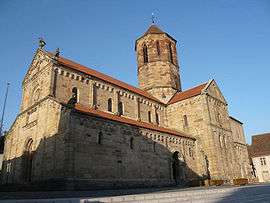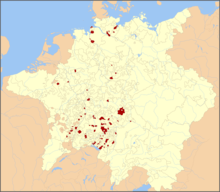Rosheim
| Rosheim | ||
|---|---|---|
| Commune | ||
 Saints-Pierre-et-Paul Church in Rosheim | ||
| ||
 Rosheim Location within Grand Est region  Rosheim | ||
| Coordinates: 48°30′N 7°28′E / 48.50°N 7.47°ECoordinates: 48°30′N 7°28′E / 48.50°N 7.47°E | ||
| Country | France | |
| Region | Grand Est | |
| Department | Bas-Rhin | |
| Arrondissement | Molsheim | |
| Canton | Molsheim | |
| Government | ||
| • Mayor (2008–14) | Michel Herr | |
| Area1 | 29.55 km2 (11.41 sq mi) | |
| Population (2006)2 | 4,776 | |
| • Density | 160/km2 (420/sq mi) | |
| Time zone | UTC+1 (CET) | |
| • Summer (DST) | UTC+2 (CEST) | |
| INSEE/Postal code | 67411 /67560 | |
| Elevation | 164–842 m (538–2,762 ft) | |
|
1 French Land Register data, which excludes lakes, ponds, glaciers > 1 km2 (0.386 sq mi or 247 acres) and river estuaries. 2 Population without double counting: residents of multiple communes (e.g., students and military personnel) only counted once. | ||
| Imperial City of Rosheim | |||||||||
|---|---|---|---|---|---|---|---|---|---|
| 1303–1679 | |||||||||
 Coat of arms
| |||||||||
| Status | Free Imperial City of the Holy Roman Empire | ||||||||
| Capital | Rosheim | ||||||||
| Government | Republic | ||||||||
| Historical era | Middle Ages | ||||||||
• First mentioned | 778 | ||||||||
| 1303 | |||||||||
|
1354 | |||||||||
| 1648 | |||||||||
| 1679 | |||||||||
| |||||||||
Rosheim is a commune in the Bas-Rhin department in Grand Est in north-eastern France.
It lies 25 km (16 mi) southwest of Strasbourg, on the eastern slopes of the Vosges mountains. It is a winemaking town on the tourist "Road of the Wines of Alsace" and the Route Romane d'Alsace ("Romanesque route of Alsace").
Geography
Distance from Paris 450 km, Strasbourg 25 km, Obernai 7 km, Molsheim 7 km.
History
From the 14th to 17th centuries, Rosheim was an Imperial City of the Holy Roman Empire, and founded the Décapole confederation with nine other Alsatian Imperial Cities in 1354. Like the other Decapolitan cities, it was awarded to France by the Peace of Westphalia and finally lost its independence under the Treaties of Nijmegen.
Sights
- Church Saint-Pierre-et-Paul (building 12th century, tower 14th century, organ 18th century)
- Church Saint-Etienne (18th century, belltower 12th century)
- Maison païenne (“pagan house”, 12th century)
- City Hall (18th century)
- Old well (Puits aux six seaux) (17th century)
- Four fortified tower-gates (13th and 14th century)
- Half-timbered houses (16th century)
Notable people
- Heinrich Eggestein (ca. 1415–88), pioneering book printer
- Josel of Rosheim (ca. 1478-1566), Jewish advocate
- Jean-Marie Lehn (born 1939), Nobel Prize 1987
- Claude Vasconi (born 1940), architect
See also
References
External links
| Wikimedia Commons has media related to Rosheim. |

